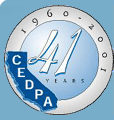

DataBus - Vol 41 No. 1: December, 2000-January, 2001
|
Spotlight on Technology: Desert Sands DesertLink
Walk into one of the classrooms in Desert Sands Unified and you will see students actively engaged in on-line learning activities designed to enhance the curriculum and promote learning. Students conduct in-depth research using Internet resources that have high-speed connections provided by microwave technology. Every spring, students and teachers participate in a Technology Fair that showcases the very best curriculum-integrated technology projects created during the academic year. The community is invited to participate in the celebration. It is not surprising that an outside evaluation conducted by Dr. Joseph Jesunathadas and Dr. James Monaghan of California State University, San Bernardino has found that the effective use of technology in this district has translated into positive academic test results for students. Technology implementation to promote teaching and learning was not a quick or simple process. According to Dr. George Araya, Desert Sands' Director of Technology, the district's commitment to the success of DesertLink was a key factor. Desert Sands has incorporated microwave technology throughout the district; all classrooms are networked and have high-speed Internet access. The one outlet that existed in each classroom for network connectivity was upgraded to up-to 24 possible connections using a Switch. Every grade 4-8 classroom has five multi-media computers. The district has its own website (http://www.dsusd.k12.ca.us) with a filter and two firewalls for protection. Students have access to e-mail through their teacher's account; for example, Ms. Smith's students would have individual accounts named Smith1, Smith2, etc. to allow teacher oversight. As with all programs that are serious about ensuring that technology is used effectively to promote student learning, DesertLink has a very strong staff development component. Teachers receive 150 hours of training that ranges from skill development to technology/curriculum integration. Training is ongoing, with teachers completing 2.5 hours a week over a two-year period. Skill-based training is available on-line 24 hours/7 days a week through NetG. They use NetG as an e-Learning-on-demand access during work hours and at home. Staff development that is project-based and promotes technology integration is given in four separate sessions on each topic area. Although the first and last sessions are mandatory, the two middle sessions are optional for those teachers who feel confident in their ability. The last session includes evaluation, presentation of the projects, and sharing of ideas. Pre and post evaluations of teacher technology proficiency are given by the staff of CSU, San Bernardino to help teachers determine what type of training would best fit their professional needs. Teachers receive laptop computers as part of the staff development program. To further support their teachers, the district provides Desert Sands On-line Community, a software program developed there that allows posting of lesson plans, threaded discussions and peer assistance and networking through bulletin board postings. The district employs five full-time technicians to keep the technology running smoothly. The hiring pool, so important to a district that integrates over 6,000 computers, comes in some cases from the high school where students may take elective classes on computer repair, networking, and infrastructure. It is important to note that one technician attends the first staff development session for project-based learning and is available to assist teachers with any technical questions they may have. Possibly the one thing that has had the most positive impact has been the hiring of four full-time teachers on special assignment. These teachers, Sue Cox, Tanya Carter, Becky Howery and Matt Blansett, have been instrumental in providing classroom support as well as needed staff development integral to the success of DesertLink. Desert Sands technology program, ably led by the forward-thinking Dr. George Araya, serves as an exemplary model of what is right with technology in education. He can be reached via e-mail at or (760) 771-8577.
Dr. Joyce Hinkson is a consultant for the California Department of Education's Education Technology Office. She may be reached at (916) 323-2241 or by e-mail at
|
CEDPA